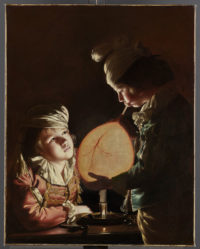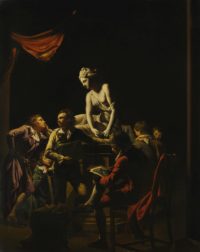 The J. Paul Getty Museum has acquired, and even more importantly received an export license for, Two Boys with a Bladder, a chiaroscuro masterpiece by 18th century British painter Joseph Wright of Derby.
The J. Paul Getty Museum has acquired, and even more importantly received an export license for, Two Boys with a Bladder, a chiaroscuro masterpiece by 18th century British painter Joseph Wright of Derby.
The recently rediscovered painting depicts two young boys, boldly lit by a concealed candle, inflating a pig’s bladder. In the 18th century, animal bladders served as toys, either inflated and tossed like balloons or filled with dried peas and shaken like rattles. While bladders appeared frequently in 17th-century Dutch painting they were depicted less frequently in 18th-century Britain. It was a motif that Wright made his own; the elaborate costumes that the boys wear are of the artist’s own invention, in the style of British “fancy pictures.” The dramatic pictorial effect created by the concentrated candle light within a dark interior setting was in vogue in much of Europe in the late 16th and 17th centuries, but it was not until the 18th century that English artists picked up the theme, Wright being among the first to do so.
Wright is famed for his nocturnal scenes. His “Candlelight Pictures” used a single candle in the center of the canvas as the sole light source to create high-contrast scenes of people clustered around a subject (the Borghese Gladiator, an orrery, a kitten) in rapt attention. Wright deployed the dramatic chiaroscuro effect pioneered by Caravaggio in his religious themed paintings for the Enlightenment interests of science, philosophy, natural history in domestic settings. Joseph Wright made the Enlightenment literal with his inky black and warm, textured light illuminating the big and small wonders of the Age of Reason, and his works were immediately popular, reproduced as large-scale prints and widely sold.
Wright’s engaged the scientific approach in his method as well as his subjects. His niece explained his inventive technique for creating nocturnal scenes:
“His mechanical genius… enabled him to construct an apparatus for painting candlelight pieces and effects of fire-light. It consisted of a framework of wood resembling a large folding screen, which reached the top of the room, the two ends being placed against a wall, which formed two sides of the enclosure. Each fold was divided into compartments, forming a framework covered with black paper, and opening with hinges, so that when the object he was painting from was placed within the proper light, the artist could view it from various points from without.”
 He made the canvas itself something of an scientific experiment, layering metal leaf underneath the focal lit area of the painting, in this case the bladder. This was a technique Wright invented to use the reflective properties of the metal to boost the shine of the faux candlelight through the layers of paint.
He made the canvas itself something of an scientific experiment, layering metal leaf underneath the focal lit area of the painting, in this case the bladder. This was a technique Wright invented to use the reflective properties of the metal to boost the shine of the faux candlelight through the layers of paint.
When another candlelight picture, An Academy by Lamplight, sold at Sotheby’s in 2017 for just under $10 million (a new record for a piece by Wright), the Arts Council recommended the government impose an export bar in the hope a British institution might raise the large sum needed to keep the painting in the country. None did and the work is now in a private collection somewhere. This time around, the Arts Council let it go without a fight.
“Two Boys with a Bladder is a remarkable discovery that sheds new light on Wright’s work at the most important moment of his career,” said Davide Gasparotto, senior curator of paintings at the Getty Museum. “It is a compelling example from his most important and successful genre, candlelight paintings. Moreover, Wright’s innovative experimentation with the use of metal foil embodies a sense of technical and scientific exploration that typifies the intellectual milieu of the midlands on the eve of the industrial revolution. It is a major addition to the Getty’s holdings of art from the English golden age.”